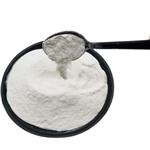Uses
Anti-adrenergic; cardiac depressant (anti-arrhythmic).
Uses
Bretylium possesses sympatholytic action, which is associated with blockage of norepinephrine
(noradrenaline) from presynaptic nerve endings. It also has a direct effect on
ischemic myocytes. Bretylium is an urgent treatment that is used in situations of ventricular
tachycardia and ventricular fibrillation, primarily in the severe phase of a myocardial
infarction, during which use of other medications or procedures have proven unsuccessful.
It requires great caution and should be used only in urgent situations.
Definition
ChEBI: A quaternary ammonium cation having 2-bromobenzyl, ethyl and two methyl groups attached to the nitrogen. It blocks noradrenaline release from the peripheral sympathetic nervous system, and is used in emergency medicine, cardiology, and other specialties fo
the acute management of ventricular tachycardia and ventricular fibrillation.
brand name
Bretylol (Mayne).
Mechanism of action
Bretylium is poorly absorbed when taken orally, and it is used only in the form of intravenous
or intramuscular injections. However, like many other quaternary ammonium salts,
it initiates a response of neuronal catechoamines, which can cause tachycardia, elevate
blood pressure, and so on.
Clinical Use
Bretylium (Bretylol) was introduced for the treatment
of essential hypertension but subsequently was shown
to suppress the ventricular fibrillation often associated
with acute myocardial infarction.
Bretylium is not to be considered a first-line antiarrhythmic
agent. However, because of its ability to prolong
the refractory period of Purkinje fibers and to elevate
the electrical threshold to ventricular fibrillation,
bretylium has been found useful in the treatment of lifethreatening
ventricular arrhythmias, especially when
conventional therapeutic agents, such as lidocaine or
procainamide, prove to be ineffective. In addition,
bretylium is known to facilitate the reversal of ventricular
fibrillation by precordial electrical shock. Its use
should be limited to no longer than 5 days.
Side effects
The most important side effect associated with the use
of bretylium is hypotension, a result of peripheral vasodilation
caused by adrenergic neuronal blockade (a
guanethidinelike action). Nausea, vomiting, and diarrhea
have been reported with IV administration and
can be minimized by slow infusion. Longer-term problems
include swelling and tenderness of the parotid
gland, particularly at mealtime.
Synthesis
Bretylium, N-(o-bromobenzyl)-N-ethyl-N,N-dimethylammonium tosylate
(18.1.22), is synthesized by reacting o-bromobenzyltosylate with ethyldimethylamine.

Precautions
The associated initial release of catecholamines may result
in an excessive pressor response and stimulation of
cardiac force and pacemaker activity. The resulting increase
in myocardial oxygen consumption in a patient
with ischemic heart disease may lead to ischemic pain
(angina pectoris). Patients in a state of circulatory shock
probably should not be administered bretylium because
of its delayed sympatholytic action.


